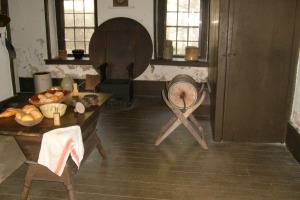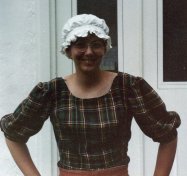The Life of a Costumed Interpreter
Back in the mid-1980s, I worked as a seasonal park
ranger/costumed interpreter at Hopewell Village National Historic Site
(now Hopewell Furnace National Historic Site) in southeastern
Pennsylvania. Hopewell is an interesting site, as it is one of the few
historic properties operated by the National Park Service that
interprets the nation’s industrial heritage prior to the Revolution
(although the main interpretive focus at the site is the 1820-1840
period). As a costumed interpreter, I dressed in “period” costume…mob
cap or bonnet, dress, apron, shoes, etc. As a female, I was expected to
focus on “women’s work” at the site, which, of course, focused on
cooking, baking, cleaning, weeding, etc., since we were interpreting
early 19th century history.
Now women at Hopewell had quite a few
responsibilities. Mothers were responsible for child rearing as well as
taking care of the home. Single women worked at the moulder’s kitchen,
which essentially served as a cafeteria for workers at the iron furnace
(both single and married, since some workers lived away from the iron
plantation). The moulder’s kitchen included the bake ovens, so when we
interpreted (explained) what was done at that part of the site, we
talked about food preparation and actually baked bread and cakes in the
bake ovens (which we then fed to the pig at the end of the workday). We
also were responsible for visitor safety, which meant we also had to
make sure that we had to keep small children from climbing on walls, on
the top of the bake ovens, etc.—and, unfortunately, my supervisor told
us we weren’t allowed to tell the story of Hansel and Gretel when
dealing with unruly children.

Kitchen area at Moulder’s Kitchen. The food on display is not authentic to the time period interpreted at Hopewell.
The life of housewives was interpreted at another
part of the village, where the tenant or workers’ houses were located.
Here, we prepared full meals (which also would be fed to the pig at the
end of the day), weeded the garden, chopped wood, cleaned…in other
words, we did what a typical housewife of the early 19th
century did. The other location where women’s work was demonstrated was
at the cleaning shed outside the cast house, where women and children
would clean the casting made by their husband/father before it was sent
to market. Again, the men manufactured, and the women cleaned.
My last year working at Hopewell, budget cuts had reduced the living
history program to one that only included moulding and casting
demonstrations at the cast house, and I worked as a park ranger
conducting tours of the historic area. In this role, I was better able
to provide a historical context for what was happening at Hopewell both
during the Revolution (where they produced cannon and shot for the
Continental Army war effort) and during the early 19th
century. Instead of being in costume, I wore the standard NPS ranger
uniform, complete with the “Smokey the Bear” hat (straw, since it was
during the summer). But I missed being in costume, because even though I
described the past in the third person (“this is what happened in the
moulder’s kitchen”) instead of first person (“I’m Ellen, and I’m one of
the girls working here in the moulder’s kitchen today”) when I was in
costume, I felt like I was more effective at presenting the past to the
public when dressed in period garb…and was more than a history teacher
who had a summer job teaching history to a non-captive audience.
The point I’m trying to make is that learning about
the past occurs in a variety of ways. Sometimes, you read about it.
Sometimes, you research and write about it. Sometimes, you visit places
to see (and perhaps experience) it. Sometimes, you get to live it like
I did during the summers of 1984 and 1985. Most important, though, is
that the past is all around us, and it’s nothing to fear. If anything,
the past is something to embrace, because it definitely shapes who we
are and what we hope to become.
My blog is going to focus on how visiting historic
sites can be fun. As someone who has worked in the field, my views will
be different from those of a typical academic historian. At the same
time, occasionally I get to see a site from someone else’s
perspective—and, in that case, the adventure is quite different from
when I experience it alone.











